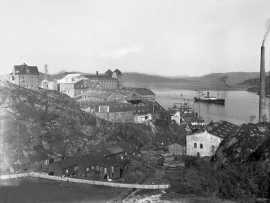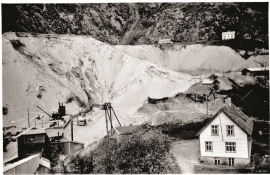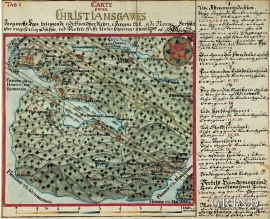- Remove Archaeology filter Archaeology
- Remove Industry, Energy and Natural Resources filter Industry, Energy and Natural Resources

Knarrevik
Having passed well over the bridge across to Sotra you pass an industrial plant surrounded by a budding community; the mineral mill of A/S Norwegian Talc. Some of the buildings seem to have been erected in the early part of the 20th century. They are remnants of a grand industrial plant from the former boom time in the country – the economic upswing after WWI.

Last Ice Age
The continental glacier that covered Hordaland was like a great power that had decisive influence over our natural history. The glaciers which at the beginning of the last ice age (more than 100,000 years ago) grew out from Folgefonna, Hardangerjøkulen and other mountainous areas, chased animals and birds, and most likely also humans in front of their paths. Small animals, plants and trees were mercilessly run over and crushed to powder under the thick ice. Even the hard bedrock got torn up and scoured by the ice, which did not give up before it reached the outer edges of the continental shelf. First 14,500 years ago, the climate became mild enough that the outer coastal strip of Hordaland once again became ice-free. Plants, animals and people started to migrate in to a landscape that was golden, with flecks of grey moraine and sand between smoothly polished rock outcrops - as our present warm interglacial was born.

Litlabø
The first finds of pyrite at Litlabø in Stord came to light in 1864. Forty years later sulphuric ore was mined from an open mine. From 1874 to 1880 it was used for dynamite production. That came to a sudden end when the factory exploded and three people died.


Lurekalven
Lurekalven is an unpopulated island of heather moor which is a part of the wilderness belonging to the five farms on Ytre Lygra. Between the two islands there is only a small sound. As late as the 1920s, milking cows were rowed over the sound from Lygra in summer – a form of farming that was adapted to the coastal landscape.


Matrehola
On a large gravel terrace in Matredalen (the Matre valley), a couple of kilometres from the coastal settlement Matre, lies Storseterhilleren, at the end of a large stone block that came rushing down from the mountain. The Matre river runs just over 100 metres to the east of the cave.

Mining in Hordaland
Ølve has the oldest known mines in Hordaland. In 1642, privilege was granted by the king to build an iron works in Jernsmuget on the property of Lilledals Farm, and five years later a copper works on the same property. Operations were suspended in 1673. Mining resumed again in the municipality in the 1750s. Also this time, in the region of Ølve.



